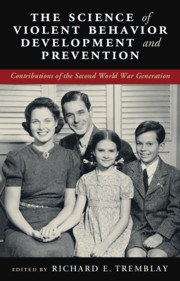 The Science of Violent Behavior Development and Prevention
The Science of Violent Behavior Development and Prevention Book contents
- The Science of Violent Behavior Development and Prevention
- The Science of Violent Behavior Development and Prevention
- Copyright page
- Contents
- Preface
- 1 Introduction: A Young Science with a Long History
- 2 From Birth in a British Orphanage to Assessments of American Indians’ Development
- 3 From Rationing, Illness, and Stress to the Creation of a Major Longitudinal Birth Cohort
- 4 From Country Girl in Southern Finland to Longitudinal Research into Alternatives to Aggression and Violence
- 5 From the Occupied Netherlands to the Pittsburgh Longitudinal Studies
- 6 From Boy to Man
- 7 Nurture and Nature
- 8 From Unruly Child to Political Protester and Promoter of an Ecology-Minded Concept of Development
- 9 From the Frustration–Aggression Hypothesis to Moral Reasoning and Action
- 10 A Tortuous Path towards Understanding and Preventing the Development of Chronic Physical Aggression
- 11 From Childhood in a Ruined German City to Research on Crime and Violence
- 12 The Last War Baby
- 13 Comments on the Autobiographies of the World War II Babies by Younger Peers
- Index
- References
10 - A Tortuous Path towards Understanding and Preventing the Development of Chronic Physical Aggression
Published online by Cambridge University Press: 28 January 2021
- The Science of Violent Behavior Development and Prevention
- The Science of Violent Behavior Development and Prevention
- Copyright page
- Contents
- Preface
- 1 Introduction: A Young Science with a Long History
- 2 From Birth in a British Orphanage to Assessments of American Indians’ Development
- 3 From Rationing, Illness, and Stress to the Creation of a Major Longitudinal Birth Cohort
- 4 From Country Girl in Southern Finland to Longitudinal Research into Alternatives to Aggression and Violence
- 5 From the Occupied Netherlands to the Pittsburgh Longitudinal Studies
- 6 From Boy to Man
- 7 Nurture and Nature
- 8 From Unruly Child to Political Protester and Promoter of an Ecology-Minded Concept of Development
- 9 From the Frustration–Aggression Hypothesis to Moral Reasoning and Action
- 10 A Tortuous Path towards Understanding and Preventing the Development of Chronic Physical Aggression
- 11 From Childhood in a Ruined German City to Research on Crime and Violence
- 12 The Last War Baby
- 13 Comments on the Autobiographies of the World War II Babies by Younger Peers
- Index
- References
Summary
Richard E. Tremblay was born in Canada in 1944. He is Emeritus Professor of Pediatrics and Psychology at the University of Montreal (Canada) and Emeritus Professor of Public Health at University College Dublin (Ireland). He received the Stockholm Prize in Criminology and the John Paul Scott Award for lifetime contributions to research on aggression from the International Society for Research on Aggression. He participated in the creation of numerous longitudinal and experimental studies to unravel the early development of chronic physical aggression and to identify effective early preventive interventions. He systematically used an integrated bio-psycho-social approach. He initially showed that boys’ frequency of physical aggressions from kindergarten to adolescence decreased, rather than increased with age as would be expected from a social learning perspective. With a study starting in infancy, he then showed that infants start to physically aggress before the end of the first year after birth and that frequency of physical aggressions substantially increase between 8 and 42 months of age, followed by a universal decrease in physical aggression frequency until adulthood. He also initiated the Montreal experimental preventive intervention with physically aggressive kindergarten boys from low socio-economic environments, which showed significant reductions of substance abuse, school drop-out, juvenile delinquency, and adult criminality.
Keywords
- Type
- Chapter
- Information
- The Science of Violent Behavior Development and PreventionContributions of the Second World War Generation, pp. 241 - 270Publisher: Cambridge University PressPrint publication year: 2021
